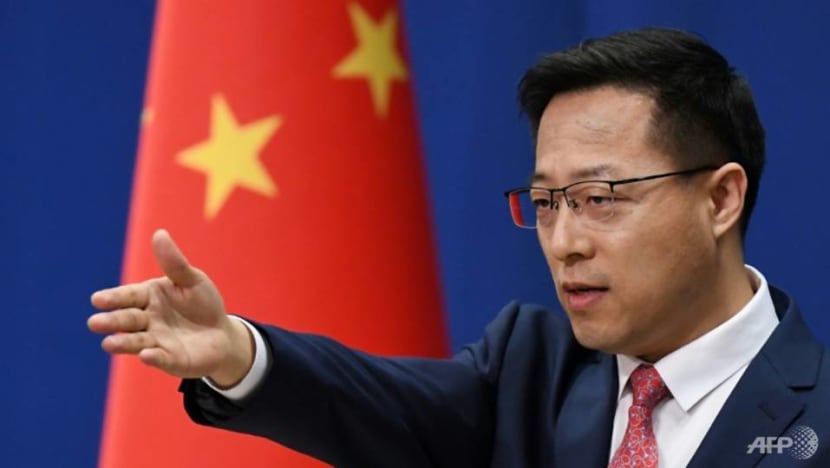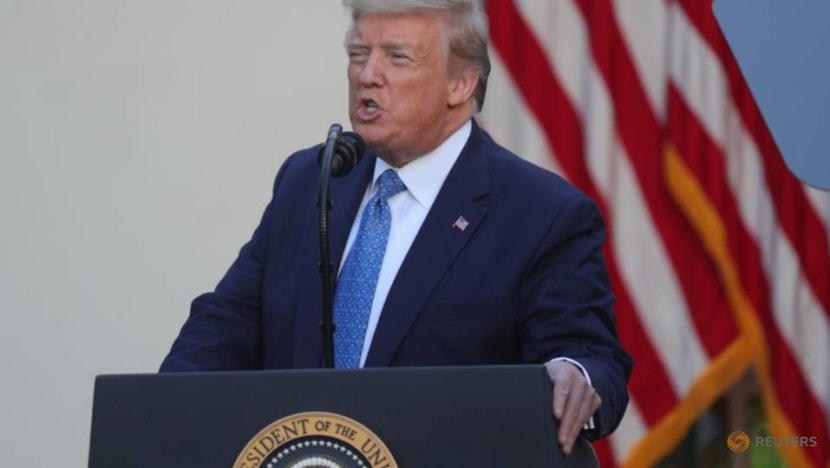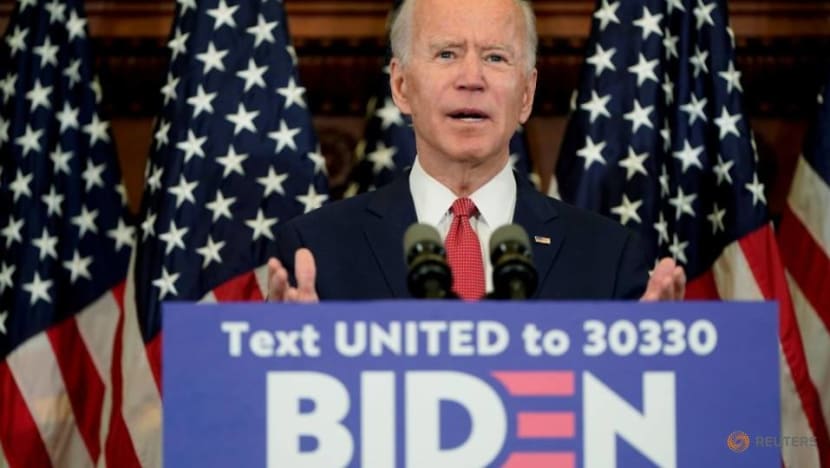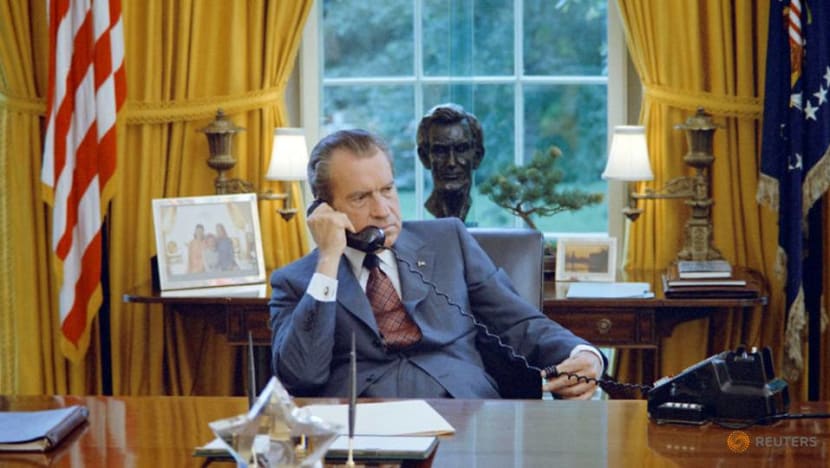commentary Commentary
Commentary: Could Donald Trump not run for re-election?
With riots in the streets and the COVID-19 death toll rising, Trump doubles down on his 2016 anti-establishment strategy. But the odds are stacked against him, say Steven R Okun and Thurgood Marshall Jr.

U.S. President Donald Trump addresses the daily coronavirus response briefing as Vice President Mike Pence listens at the White House in Washington, U.S., April 2, 2020. (Photo: REUTERS/Tom Brenner)
SINGAPORE: Five months from election day, Donald Trump faces possibly the most daunting challenge ever for a sitting US president running for re-election.
A collapsing economy. Over 100,000 COVID-19 deaths. Riots across the country.
A disapproval rating higher at this stage in a presidency than that of any of his post-World War II predecessors.
Donald Trump had a very narrow path to victory in 2016, but he successfully “threaded the needle” in the electoral college against a historically unpopular opponent while losing the overall vote by nearly 3 million.
There is no chance he wins a majority of the vote this time. In big blue states like California and New York, he could lose by better than two to one. A realistic loss in the popular vote could be by 4 to 5 million votes.
TRUMP’S 2020 ROADMAP
To win a second tine, Trump must take advantage of the structural asymmetry of the electoral college which favours states with rural, white populations.
He will double down on his 2016 playbook of by appealing to the white majority (estimated to be two-thirds of the vote this year) who worry about the unravelling of America while at the same time suppressing the vote of his opponent.
In 2016, Trump’s combined anti-establishment rhetoric and conservative positions on social policy appealed to 46 per cent of US voters. Trump won by targeting lower- and middle-class white voters with a message that the system has failed them, the government is against them and all institutions such as the media are their enemy.

His brutal mocking and unanswered attacks on Hillary Clinton helped keep voters who might have voted for her otherwise from going to the polls.
For his entire presidency, the Trump messaging and campaign strategy has blended scapegoating and blame-shifting with grandstanding on accomplishments large and small.
He has never missed an opportunity to seize upon breaking events to apply that strategy. He quickly replays his greatest hits whenever he can, sometimes without any precipitating events or simply as a distraction.
READ: Commentary: Will a US president facing impeachment manufacture a foreign policy crisis?
READ: Commentary: Trump fights a two-front war on the coronavirus
CHINA WILL BE TRUMP’S WHIPPING BOY
Foremost on that list lies his xenophobic obsession with China.
Donald Trump was correct that the bipartisan approach towards China of “engage and accommodate” had run its course and did not produce the results sought. President Obama began to shift away from that strategy with the Trans-Pacific Partnership. But Donald Trump took it into a wholly different direction.
China was always going to play a major role in the campaign as it permitted him to differentiate himself from Joe Biden and his representation of the past US approach to China.
COVID-19’s origins in China coupled with the new national security law in Hong Kong have served up another opportunity for him. True to form, Trump has opted to play to his supporters than to exert global leadership, such as by choosing to destroy US ties with the WHO and painting the organisation as a vessel of China.
Trump claims that but for China, the United States would be experiencing its greatest economy of all time.
READ: Commentary: The US-China relationship just got a lot more complicated

On the domestic front, Trump finds himself battling Twitter and their efforts to flag his more extreme tweets as he faces massive urban protests and unrest over the brutal death of George Floyd at the hands of unscrupulous police officers in Minneapolis.
Through it all, he has sought to maintain a predictable posture as his base’s protector uniquely equipped to deliver results while casting blame on local elected officials.
If the election becomes a referendum on how the Trump Administration responded to the pandemic, he would most likely lose. He cannot afford for George Floyd to be an election issue against him, too.
So he’s attempting to shift the narrative from civil rights to “law and order”.
READ: Commentary: George Floyd's death and the rising spectre of a race-based US election

SUPPRESS THE VOTE
While Trump suffers setbacks, his opponent looks real good. Amid these difficult three months, Joe Biden has had only limited opportunities to make front page news. Yet, his overall approval and national poll numbers have improved.
For Donald Trump to win, he needs to make sure as few people as possible vote for Joe Biden. He must stop that rise in the polls.
There are two ways to do this.
READ: Commentary: Why George Floyd's death could tilt the US election - in Trump's favour
READ: Commentary: Can Trump really order the military to move into US cities?
First, attack Joe Biden viciously so undecided voters or those leaning towards voting for Biden do not vote at all. Between Biden’s son Hunter’s business dealings, Biden’s perceived softness on China and Biden’s perceived gaffs, he has ammunition.
Second, make it difficult for those people who want to vote for Biden to actually do so. This battle plays out in real-time over vote-by-mail. “We don’t want anyone to do mail-in ballots,” President Trump said in May.
Generally speaking, the two demographic groups that vote by mail the least under the existing requirements in many states before one can receive an absentee ballot are younger voters and African Americans who tend to wait until election day to vote if they vote at all. When they do vote, these two groups disproportionately vote for the Democrats.
If states make it easier to get an absentee ballot, such as by sending one to all voters proactively, this should increase the margin of victory for Biden as it will increase the number of younger and African American voters.

With the US president and the Republican Party claiming there needs to be protections against voter fraud when it comes to vote by mail, such as ballots being sent to the deceased or those who have moved, they build a strategy to limit any expansion of mail-in voting for all.
Democrats have a very difficult legal fight on their hands. All the Republicans need to do is keep change from happening.
HISTORY SUGGESTS TRUMP MAY NOT WIN RE-ELECTION
Even Donald Trump may not be able to overcome dealing with a pandemic, economic collapse and nationwide civil unrest. Historically, no incumbent party has been able to overcome even one of those challenges.
In the pandemic mid-term election of 1918, the party out of power in the Senate (the Republicans) picked-up six seats to gain control.
In the first election during the Great Depression in 1932, the Democrats won both the White House and Senate back from the Republicans.
In 1968, the last election where there was great civil unrest, the Republicans took the White House.
This year combines all three of these challenges. No precedent exists for a Trump second term.
READ: Commentary: Who would Beijing prefer wins the US presidential election in November?
READ: Commentary: Imagine holding the US elections during a COVID-19 outbreak
TRUMP’S OTHER ROADMAP: LYNDON JOHNSON IN 1968
While impossible to contemplate it actually happening, it would be in Trump’s objective best interest to not run for a second term and allow Mike Pence to be the Republican nominee.
In 1968, President Lyndon Baines Johnson was completing his first full term in office and was contemplating running for a second. The United States was mired in the Vietnam War and anti-war protests raged across college campuses.
Johnson shocked the country by announcing his decision not to seek another term that March.
In speaking to the country from the Oval Office, President Johnson said he did not want to permit the presidency to become involved in the country’s partisan divisions.
“With America's sons in the fields far away, with America's future under challenge right here at home, with our hopes and the world's hopes for peace in the balance every day, I do not believe that I should devote an hour or a day of my time to any personal partisan causes or to any duties other than the awesome duties of this office - the Presidency of your country.”
That year’s election pitted Johnson’s Vice-President, Hubert Humphrey, against Richard Nixon.

Even with the unpopularity of the Vietnam War and the great civil unrest, Nixon only won by margin of 0.7 per cent of the popular vote against the incumbent party.
Objectively, Pence would have a better chance at winning than Trump in November. He would have all the upside of where Republicans like Trump’s policies coupled without the baggage built-up the past three and a half years.
Having Vice-President Pence succeed him would afford some political protection against what Trump would face with the Democrats mounting massive investigations of his time in office if they were to win the White House.
Logical? Yes.
Possible? No.
But it’s 2020.
Steven R Okun and Thurgood Marshall Jr served in the Clinton administration as Deputy General Counsel at the Department of Transportation and White House Cabinet Secretary, respectively. Mr Okun serves as senior adviser for global strategic consultancy McLarty Associates in Singapore. Mr Marshall practices law in Washington.
















